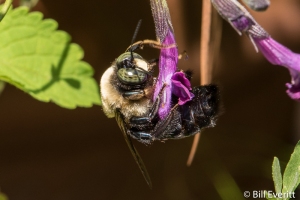Every third bite of food you take, thank a bee or other pollinator. – E. O. Wilson
There were no honey bees in North America before Europeans brought them. [5] But there were our own native bees – over 3,500 species in North America. [1]
Native bees are excellent pollinators. Did you know that:
- For watermelons, native bees do 90 percent of the pollination. [12]
- Native bees improve fruit production in apples. [13]
- Native bee pollination creates twice as much fruit as honey bees in blueberries [14].
- For tomatoes, native bee species increase fruit production significantly [15].
- Honey bees aren’t physically big enough to successfully pollinate tomatoes; it takes a burly bumble bee to do the job.
- In a lot of crops, specialist pollinators do a better job than generalist honey bees.
list from You’re Worrying About The Wrong Bees – Wired Magazine
Important native bees in Georgia include:
- Bumble bees. These are large, fuzzy bees which are social like honey bees. Their life cycle begins with a solitary overwintered queen. [2]
- Soil-nesting bees. This group includes thousands of species. These bees are solitary, which means individual females emerge in the spring and, mate, forage, and single-handedly rear the next generation of offspring. [2]
- Mason bees. These are solitary bees that nest in pre-existing tunnels such as old nail holes, beetle tunnels, or soda straws. They are called mason bees because they seal their tunnels with mud or finely-chewed leaf material. [2]
- Carpenter Bees: Carpenter bees, which may be mistaken for Bumble bees are large, sturdy, shiny, black-colored bees. They are so named because nearly all species build their nests in burrows in dead wood, bamboo, or structural timbers. [8]
Do native bees sting? It’s only the bees that live in a colony or hive (“social bees,” i.e., honey bees and bumble bees) that are likely to sting, because they have a colony to defend. Most native social bees do not defend their hive aggressively. Of the forty-five species of bumble bees in the U.S., only about four have a feisty nature. [3] In fact, there are some bees that are incapable of stinging humans because their stingers are too small and weak to penetrate their skin. [5]
Native bees are in trouble. While Native bees don’t suffer from Colony Collapse Disorder, they are facing other serious issues such as habitat loss and pesticides.
All types of pesticides have been found to harm bees, including fungicides, herbicides, acaricides, rodenticides, and of course the ubiquitous insecticides. Since native bees are closely tied to their food source, anything that destroys the food source—whether it’s a herbicide, a freeway, or a housing development—destroys the native insects that were dependent upon it. [7]
You can help. Here are some things you can do:
-
Plant a pollinator garden.
- Avoid pesticides. Where appropriate, consider using organic pesticides. For example, aphids can be easily removed by spraying them with water from a garden hose.
- Provide a source of pesticide-free water and mud. A dripping faucet, mud puddle, or birdbath attracts butterflies and beneficial insects. Mud is an important nesting material for some bee species.
- Plant the kind of lawn that provides habitat beneficial to bees. Allow some small wildflowers to become part of your lawn. Clover is great food for native bees. It also fixes nitrogen, reducing the need for fertilizers.
- Provide nesting habitats for bees. Standing dead trees (snags) are important nesting habitats for 30 percent of our native bees. Drilling holes on an old post or even a tree trunk would also make good nesting sites.
-
Build or buy your own bee houses. You can also tie up a bunch of hollow twigs, such as elderberry, or paper (not plastic!) drinking straws together. place them horizontally facing south or southeast. They should be closed at one end. (see [9] below)
points are excerpts from Bee Basics – An Introduction to Our Native Bees – USDA
References and Additional Information
[1] Georgia Gwinnet College: Bees of Georgia
[2] Xerces Society: Pollinator Conservation Resources – Southeast Region
[3] Xerces Society: Native Bee Biology
[4] University of Georgia College of Agricultural & Environmental Sciences: Bee Conservation in the Southeast
[5] USDA: Bee Basics – An Introduction to Our Native Bees
[6] USDA Forest Service: Bumblebees of the Eastern United States
[7] Native Bee Conservancy
[8] Wikipedia: Carpenter Bee
[9] National Wildlife Federation: How to Build a Bee House
[10] Xerces Society: Pollinator Plants – Southeast Region
[11] Wired: You’re Worrying About The Wrong Bees
[12] U.S. National Library of Medicine: Native bees provide insurance against ongoing honey bee losses
[13] Science Direct: Pollination services are mediated by bee functional diversity and landscape context
[14] Wired: Native Bees Increase Blueberry Crop Yields
[15] Science Direct: Wild bee species increase tomato production and respond differently to surrounding land use in Northern California






Good concise information about the bees. Important to let people know that not all bees sting. Maybe they won’t be so frightened and rush to kill them
LikeLike